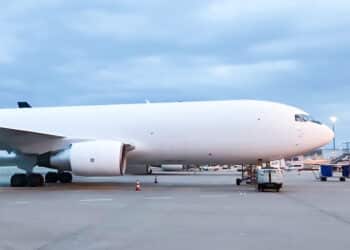Atran launches weekly China-Europe flights for Cainaio
Russia-based Atran launched weekly scheduled flights between Hangzhou (HGH) and Riga (RIX) via Moscow Vnukovo (VKO) and other intermediate airports for Alibaba’s logistics-arm, Cainiao. The flights will utilize a 23-tonne capacity 737-800BCF and depart Hangzhou every Thursday.
Although the new route will contribute to higher asset utilization for Atran’s -800BCF, independent of other business, the service alone will not justify the lease rate for the 737-800BCF. Cargo Facts expects Cainiao will either continue to launch China-Europe cross-border flights with the aircraft, or Atran will look to develop business elsewhere to boost flying time for the NG freighter. At least in the near-term, it appears Cainiao has no plans to control the full extent of the aircraft’s capacity. The aircraft is currently available for charters, according to posts on social media from company sales personnel.
Longer term, however, Cainiao could continue to work with Atran to launch new routes. The Russian carrier hinted at Cainiao’s involvement with the 737-800BCFs back in October 2018, when it was first announced that Atran would add two 737-800BCFs to its fleet. At the time, Paul Nolan, Fleet Development Director, CargoLogicManagement, said that the 737-800BCFs would help Atran “achieve its strategic objectives” for express and e-commerce customers with flights between Russia and China. Shortly after the order was announced, in December 2018, Atran’s parent, Volga-Dnepr Group, and Cainiao entered into an MoU that designated Atran and its affiliate carriers as “preferred” carriers for Cainiao’s “airlift capacity and logistics services.” The extent to which Cainiao utilizes capacity operated by Volga-Dnepr Group carriers remains to be seen.
Should Cainiao desire to connect more city pairs like Hangzhou and Riga (via intermediate connections), there’s no doubt the 737 NGs could be suitable. Other carriers have already deployed the aircraft for express, e-commerce, and even some general cargo missions – most of the assets, however, are utilized extensively. Seattle-based Alaska Airlines, which operates three 737-700BDSFs, previously noted utilization averaged 10.5 hours per day. An initial glimpse into Southern Air’s 737-800BCF operations for Amazon Air also revealed extensive use of the aircraft. Other 737-800 operators, such as Sweden-based West Atlantic, previously told Cargo Facts they would have difficulty operating the aircraft on low-utilization routes. However, once utilization passes the 100-hours-per-month level, choosing it [over a 737 Classic] is “a no-brainer.” (See more, here).
Returning to Atran’s 737-800BCF, based on the sparse and incomplete flight data available, it does not appear the aircraft is yet flying 100+ hours per month. As part of Atran’s October 2018 agreement with GECAS, the carrier has at least one 737-800BCF remaining on order with GECAS. Originally the second unit was expected to be introduced during the first half of 2019, but it’s unclear if the redelivery remains on schedule. Apart from the 737-800BCF, Atran’s fleet currently includes four 737-400Fs – though as we’ve previously reported, one of the 737 Classics may be headed for Volga-Dnepr’s newest startup, CargoLogic Germany. Regardless, Volga-Dnepr Group carriers are increasingly involved in narrowbody freighter operations.




